Species Mixing Effects on Height–Diameter and Basal Area Increment Models for Scots Pine and Maritime Pine
Abstract
1. Introduction
2. Materials and Methods
2.1. Data
2.2. Generalized Height–Diameter Functions
2.3. Tree Growth Model
2.4. Model Evaluation
3. Results
3.1. Generalized Height–Diameter Selected Models
3.2. Height–Diameter Function Validation
3.3. Basal Area Increment Model
4. Discussion
4.1. Influence on Species-Mixing in Tree Allometry
4.2. Tree Basal Area Growth Models Adapted to Mixed Stands
4.3. Implication for Tree-Level Model in Mixed Stands
5. Conclusions
Supplementary Materials
Author Contributions
Funding
Acknowledgments
Conflicts of Interest
References
- Van Der Plas, F.; Manning, P.; Allan, E.; Scherer-Lorenzen, M.; Verheyen, K.; Wirth, C.; Zavala, M.A.; Hector, A.; Ampoorter, E.; Baeten, L.; et al. Jack-of-all-trades effects drive biodiversity-ecosystem multifunctionality relationships in European forests. Nat. Commun. 2016, 7, 11109. [Google Scholar] [CrossRef]
- Pretzsch, H.; Forrester, D.I.; Rötzer, T. Representation of species mixing in forest growth models. A review and perspective. Ecol. Model. 2015, 313, 276–292. [Google Scholar] [CrossRef]
- Coll, L.; Ameztegui, A.; Collet, C.; Löf, M.; Mason, B.; Pach, M.; Verheyen, K.; Abrudan, I.; Barbati, A.; Barreiro, S.; et al. Knowledge gaps about mixed forests: What do European forest managers want to know and what answers can science provide? For. Ecol. Manag. 2018, 407, 106–115. [Google Scholar] [CrossRef]
- Felton, A.; Nilsson, U.; Sonesson, J.; Felton, A.M.; Roberge, J.M.; Ranius, T.; Ahlström, M.; Bergh, J.; Björkman, C.; Boberg, J.; et al. Replacing monocultures with mixed-species stands: Ecosystem service implications of two production forest alternatives in Sweden. Ambio 2016, 45, 124–139. [Google Scholar] [CrossRef]
- Gadow, K.V.; Zhang, C.Y.; Wehenkel, C.; Pommerening, A.; Corral-Rivas, J.; Korol, M.; Myklush, S.; Gang, Y.H.; Kiviste, A.; Zhao, X.H. Forest Structure and Diversity. In Continuous Cover Forestry, Book Series Managing Forest Ecosys-Tems; Pukkala, T., von Gadow, K., Eds.; Springer: Berlin, Germany, 2012; Volume 23, pp. 29–84. [Google Scholar]
- Pretzsch, H.; Zenner, E.K. Toward managing mixed-species stands: From parametrization to prescription. For. Ecosyst. 2017, 4, 19. [Google Scholar] [CrossRef]
- Zhang, Y.; Chen, H.Y.H.; Reich, P.B. Forest productivity increases with evenness, species richness and trait variation: A global meta-analysis. J. Ecol. 2012, 100, 742–749. [Google Scholar] [CrossRef]
- Dănescu, A.; Albrecht, A.T.; Bauhus, J. Structural diversity promotes productivity of mixed, uneven-aged forests in southwestern Germany. Oecologia 2016, 182, 319–333. [Google Scholar] [CrossRef]
- Del Río, M.; Bravo-Oviedo, A.; Ruiz-Peinado, R.; Condés, S. Tree allometry variation in response to intra- and inter-specific competitions. Trees 2018, 33, 121–138. [Google Scholar] [CrossRef]
- Sharma, R.P.; Vacek, Z.; Vacek, S.; Podrázský, V.; Jansa, V. Modelling individual tree height to crown base of Norway spruce (Picea abies (L.) Karst.) and European beech (Fagus sylvatica L.). PLoS ONE 2017, 12, e0186394. [Google Scholar] [CrossRef]
- Condés, S.; del Río, M. Climate modifies tree interactions in terms of basal area growth and mortality in monospecific and mixed Fagus sylvatica and Pinus sylvestris forests. Eur. J. For. Res. 2015, 134, 1095–1108. [Google Scholar] [CrossRef]
- Pretzsch, H.; Biber, P. Tree species mixing can increase maximum stand density. Can. J. For. Res. 2016, 46, 1179–1193. [Google Scholar] [CrossRef]
- Jonsson, M.; Bengtsson, J.; Gamfeldt, L.; Moen, J.; Snäll, T. Levels of forest ecosystem services depend on specific mixtures of commercial tree species. Nat. Plants 2019, 5, 141–147. [Google Scholar] [CrossRef]
- Zeller, L.; Pretzsch, H. Effect of forest structure on stand productivity in Central European forests depends on developmental stage and tree species diversity. For. Ecol. Manag. 2019, 434, 193–204. [Google Scholar] [CrossRef]
- Toïgo, M.; Vallet, P.; Perot, T.; Bontemps, J.-D.; Piedallu, C.; Courbaud, B. Overyielding in mixed forests decreases with site productivity. J. Ecol. 2015, 103, 502–512. [Google Scholar] [CrossRef]
- Del Río, M.; Pretzsch, H.; Alberdi, I.; Bielak, K.; Bravo, F.; Brunner, A.; Condés, S.; Ducey, M.J.; Fonseca, T.; von Lüpke, N.; et al. Characterization of the structure, dynamics, and productivity of mixed-species stands: Review and perspectives. Eur. J. For. Res. 2016, 135, 23–49. [Google Scholar] [CrossRef]
- Pretzsch, H. Canopy space filling and tree crown morphology in mixed-species stands compared with monocultures. For. Ecol. Manag. 2014, 327, 251–264. [Google Scholar] [CrossRef]
- Hann, D.W.; Walters, D.K.; Scrivani, J.A. Incorporating crown ratio into prediction equations for Douglas-fir stem volume. Can. J. For. Res. 1987, 17, 17–22. [Google Scholar] [CrossRef]
- Burkhart, H.E.; Walton, S.B. Incorporating crown ratio into taper equations for loblolly pine trees. For. Sci. 1985, 31, 478–484. [Google Scholar]
- Garber, S.M.; Maguire, D.A. Modeling stem taper of three central Oregon species using nonlinear mixed effects models and autoregressive error structures. For. Ecol. Manag. 2003, 179, 507–522. [Google Scholar] [CrossRef]
- Calama, R.; Barbeito, I.; Pardos, M.; del Río, M.; Montero, G. Adapting a model for even-aged Pinus pinea L. stands to complex multi-aged structures. For. Ecol. Manag. 2008, 256, 1390–1399. [Google Scholar] [CrossRef]
- Sterba, H.; Blab, A.; Katzensteiner, K. Adapting an individual tree growth model for Norway spruce (Picea abies L. Karst.) in pure and mixed species stands. For. Ecol. Manag. 2002, 159, 101–110. [Google Scholar] [CrossRef]
- Bravo, F.; Álvarez-González, J.G.; del Río, M.; Barrio-Anta, M.; Bravo-Oviedo, A.; Calama, R.; Castedo-Dorado, F.; Crecente-Campo, F.; Condés, S. Growth and Yield Models in Spain: Historical Overview, Contemporary Examples and Perspectives; Instituto Universitario de Investigación en Gestión Forestal Sostenible: Madrid, Spain, 2012. [Google Scholar]
- Bravo, F. Dinámica de Rodales de Pino Negral (Pinus pinaster Ait.) en el Sistema Ibérico Meridional: Estructura Genética, Regeneración y Dinámica Forestal; Project report AGL-2001-1780; Instituto Universitario de Investigación en Gestión Forestal Sostenible: Palencia, Spain, 2005. [Google Scholar]
- Lizarralde, I.; Ordoñez, A.C.; Bravo-Oviedo, A.; Bravo, F. IBEROPS: Modelo de Dinámica de Rodales de Pinus sylvestris L. en Castilla y León. 2010. Available online: www.simanfor.es (accessed on 13 January 2018).
- Lizarralde, I.; Ordoñez, A.C.; Bravo-Oviedo, A.; Bravo, F. IBEROPT: Modelo de Dinámica de Rodales de Pinus pinaster Ait. en el Sistema Ibérico Meridional. 2010. Available online: www.simanfor.es (accessed on 13 January 2018).
- Lizarralde, I. Dinámica de Rodales y Competencia en las Masas de Pino Silvestre (Pinus sylvestris) y Pino Negral (Pinus pinaster Ait.) de los Sistemas Central e Ibérico Meridional. Ph.D. Thesis, Universidad de Valladolid, Valladolid, Spain, 2008. [Google Scholar]
- Bravo-Oviedo, A.; del Río, M.; Montero, G. Site index curves and growth model for Mediterranean maritime pine (Pinus pinaster Ait.) in Spain. For. Ecol. Manag. 2004, 201, 187–197. [Google Scholar] [CrossRef]
- Rojo, A.; Montero, G. El Pino Silvestre en la Sierra de Guardarrama; Ministerio de Agricultura, Pesca y Alimentación: Madrid, Spain, 1996.
- Bravo, F.; Montero, G. Site index estimation in Scots pine (Pinus sylvestris L.) stands in the High Ebro Basin (northern Spain) using soil attributes. Forestry 2001, 74, 395–406. [Google Scholar] [CrossRef]
- Bravo, F.; Pando, V.; Ordóñez, C.; Lizarralde, I. Modelling ingrowth in mediterranean pine forests: A case study from scots pine (Pinus sylvestris L.) and mediterranean maritime pine (Pinus pinaster Ait.) stands in Spain. For. Syst. 2008, 17, 250–260. [Google Scholar] [CrossRef]
- Bravo-Oviedo, A.; Sterba, H.; Del Río, M.; Bravo, F. Competition-induced mortality for Mediterranean Pinus pinaster Ait. and P. sylvestris L. For. Ecol. Manag. 2006, 222, 88–98. [Google Scholar] [CrossRef]
- Riofrío, J.; del Río, M.; Pretzsch, H.; Bravo, F. Changes in structural heterogeneity and stand productivity by mixing Scots pine and Maritime pine. For. Ecol. Manag. 2017, 405, 219–228. [Google Scholar] [CrossRef]
- Riofrío, J.; del Río, M.; Bravo, F. Mixing effects on growth efficiency in mixed pine forests. Forestry 2017, 90, 381–392. [Google Scholar] [CrossRef]
- López-Marcos, D.; Martínez-Ruiz, C.; Turrión, M.B.; Jonard, M.; Titeux, H.; Ponette, Q.; Bravo, F. Soil carbon stocks and exchangeable cations in monospecific and mixed pine forests. Eur. J. For. Res. 2018, 137, 831–847. [Google Scholar] [CrossRef]
- Lara, W.; Bravo, F.; Sierra, C.A. measuRing: An R package to measure tree-ring widths from scanned images. Dendrochronologia 2015, 34, 43–50. [Google Scholar] [CrossRef]
- Bunn, A.G. Statistical and visual crossdating in R using the dplR library. Dendrochronologia 2010, 28, 251–258. [Google Scholar] [CrossRef]
- Calama, R.; Montero, G. Interregional nonlinear height-diameter model with random coefficients for stone pine in Spain. Can. J. For. Res. 2004, 34, 150–163. [Google Scholar] [CrossRef]
- Sharma, M.; Parton, J. Height-diameter equations for boreal tree species in Ontario using a mixed-effects modeling approach. For. Ecol. Manag. 2007, 249, 187–198. [Google Scholar] [CrossRef]
- Temesgen, H.; Zhang, C.H.; Zhao, X.H. Modelling tree height-diameter relationships in multi-species and multi-layered forests: A large observational study from Northeast China. For. Ecol. Manag. 2014, 316, 78–89. [Google Scholar] [CrossRef]
- Saud, P.; Lynch, T.B.; Anup, K.C.; Guldin, J.M. Using quadratic mean diameter and relative spacing index to enhance height–diameter and crown ratio models fitted to longitudinal data. For. Ann. Int. J. For. Res. 2016, 89, 215–229. [Google Scholar] [CrossRef]
- Pinheiro, J.; Bates, D. Mixed-Effects Models in S and S-PLUS; Springer: Berlin, Germany, 2000. [Google Scholar]
- Quicke, H.E.; Meldahl, R.S.; Kush, J.S. Basal area growth of individual trees—A model derived from a regional longleaf pine growth study. For. Sci. 1994, 40, 528–542. [Google Scholar]
- Thürig, E.; Kaufmann, E.; Frisullo, R.; Bugmann, H. Evaluation of the growth function of an empirical forest scenario model. For. Ecol. Manag. 2005, 204, 51–66. [Google Scholar] [CrossRef]
- Sterba, H.; del Río, M.; Brunner, A.; Condés, S. Effect of species proportion definition on the evaluation of growth in pure vs. mixed stands. For. Syst. 2014, 23, 547–559. [Google Scholar] [CrossRef]
- del Río, M.; Condés, S.; Pretzsch, H. Analyzing size-symmetric vs. size-asymmetric and intra- vs. inter-specific competition in beech (Fagus sylvatica L.) mixed stands. For. Ecol. Manag. 2014, 325, 90–98. [Google Scholar] [CrossRef]
- del Río, M.; Montero, G.; Bravo, F. Analysis of diameter—Density relationships and self-thinning in non-thinned even-aged Scots pine stands. For. Ecol. Manag. 2001, 142, 79–87. [Google Scholar] [CrossRef]
- Anderson, D.R. Model. Based Inferences in the Life Sciences: A Primer on Evidence; Springer: Berlin, Germany, 2007. [Google Scholar]
- Pinheiro, J.; Bates, D.; DebRoy, S.; Sarkar, D. Nlme: Linear and Nonlinear Mixed Effects Models. R Package Version 3.1-317. 2018. Available online: https://CRAN.R-project.org/package=nlme (accessed on 12 February 2019).
- Sharma, R.P.; Vacek, Z.; Vacek, S.; Kučera, M. Modelling individual tree height–diameter relationships for multi-layered and multi-species forests in central Europe. Trees 2018, 33, 103–119. [Google Scholar] [CrossRef]
- Mina, M.; del Río, M.; Huber, M.O.; Thürig, E.; Rohner, B. The symmetry of competitive interactions in mixed Norway spruce, silver fir and European beech forests. J. Veg. Sci. 2018, 29, 775–787. [Google Scholar] [CrossRef]
- Forrester, D.I.; Pretzsch, H. Tamm Review: On the strength of evidence when comparing ecosystem functions of mixtures with monocultures. For. Ecol. Manag. 2015, 356, 41–53. [Google Scholar] [CrossRef]
- Zeide, B.; VanderSchaaf, C. The Effect of Density on the Height-Diameter Relationship; Gen. Tech Report; USDA, Forest Service, Southern Research Station: Asheville, NC, USA, 2002; pp. 463–466.
- Vargas-Larreta, B.; Castedo-Dorado, F.; Álvarez-González, J.G.; Barrio-Anta, M.; Cruz-Cobos, F. A generalized height-diameter model with random coefficients for uneven-aged stands in El Salto, Durango (Mexico). Forestry 2009, 82, 445–462. [Google Scholar] [CrossRef]
- Huang, S.; Wiens, D.P.; Yang, Y.; Meng, S.X.; Vanderschaaf, C.L. Assessing the impacts of species composition, top height and density on individual tree height prediction of quaking aspen in boreal mixedwoods. For. Ecol. Manag. 2009, 258, 1235–1247. [Google Scholar] [CrossRef]
- Pinto, P.E.; Gégout, J.C.; Hervé, J.C.; Dhôte, J.F. Respective importance of ecological conditions and stand composition on Abies alba Mill. dominant height growth. For. Ecol. Manag. 2008, 255, 619–629. [Google Scholar] [CrossRef]
- Erickson, H.; Harrington, C.; Marshall, D. Tree growth at stand and individual scales in two dual-species mixture experiments in southern Washington State, USA. Can. J. For. Res. 2009, 39, 1119–1132. [Google Scholar] [CrossRef]
- Thurm, E.A.; Pretzsch, H. Improved productivity and modified tree morphology of mixed versus pure stands of European beech (Fagus sylvatica) and Douglas-fir (Pseudotsuga menziesii) with increasing precipitation and age. Ann. For. Sci. 2016, 73, 1047–1061. [Google Scholar] [CrossRef]
- Oliver, C.D.; Larson, B.A.; Larson, B.C. Forest Stand. Dynamics: Updated Edition; John Wiley & Sons: Hoboken, NJ, USA, 1996. [Google Scholar]
- Gaudio, N.; Balandier, P.; Perret, S.; Ginisty, C. Growth of understorey Scots pine (Pinus sylvestris L.) saplings in response to light in mixed temperate forest. Forestry 2011, 84, 187–195. [Google Scholar] [CrossRef]
- Vizcaíno-Palomar, N.; Ibañez, I.; González-Martínez, S.C.; Zavala, M.A.; Alía, R. Adaptation and plasticity in aboveground allometry variation of four pine species along environmental gradients. Ecol. Evol. 2016, 6, 7561–7573. [Google Scholar] [CrossRef]
- Poorter, L.; Lianes, E.; Moreno-de las Heras, M.; Zavala, M.A. Architecture of Iberian canopy tree species in relation to wood density, shade tolerance and climate. Plant. Ecol. 2012, 213, 707–722. [Google Scholar] [CrossRef]
- Cattaneo, N. Competencia, Productividad y Cambios a Nivel de Copas en Bosques Mixtos de Pinos Mediterráneos, Señales a Nivel del Árbol Individual. Ph.D. Thesis, University of Valladolid, Valladolid, Spain, 2018. [Google Scholar]
- Jucker, T.; Bouriaud, O.; Avacaritei, D.; Dǎnilǎ, I.; Duduman, G.; Valladares, F.; Coomes, D.A. Competition for light and water play contrasting roles in driving diversity-productivity relationships in Iberian forests. J. Ecol. 2014, 102, 1202–1213. [Google Scholar] [CrossRef]
- Liang, J.; Buongiorno, J.; Monserud, R.; Kruger, E.; Zhou, M. Effects of diversity of tree species and size on forest basal area growth, recruitment, and mortality. For. Ecol. Manag. 2007, 243, 116–127. [Google Scholar] [CrossRef]
- Garber, S.M.; Maguire, D.A. Stand Productivity and Development in Two Mixed-Species Spacing Trials in the Central Oregon Cascades. For. Sci. 2004, 50, 92–105. [Google Scholar]
- Navarro-Cerrillo, R.M.; Sánchez-Salguero, R.; Herrera, R.; Ruiz, C.J.C.; Moreno-Rojas, J.M.; Manzanedo, R.D.; López-Quintanilla, J. Contrasting growth and water use efficiency after thinning in mixed Abies pinsapo-Pinus pinaster-Pinus sylvestris forests. J. For. Sci. 2016, 62, 53–64. [Google Scholar]
- Granda, E.; Gazol, A.; Camarero, J.J. Functional diversity differently shapes growth resilience to drought for co-existing pine species. J. Veg. Sci. 2018, 29, 265–275. [Google Scholar] [CrossRef]
- del Río, M.; Montero, G. Modelo de Simulación de Claras en Masas de Pinus sylvestris L.; Monografía, Ministerio de Ciencia y Tecnología: Madrid, Spain, 2001.
- Dănescu, A.; Albrecht, A.T.; Bauhus, J.; Kohnle, U. Geocentric alternatives to site index for modeling tree increment in uneven-aged mixed stands. For. Ecol. Manag. 2017, 392, 1–12. [Google Scholar] [CrossRef]
- Moreno-Fernández, D.; Álvarez-González, J.G.; Rodríguez-Soalleiro, R.; Pasalodos-Tato, M.; Cañellas, I.; Montes, F.; Díaz-Varela, E.; Sánchez-González, M.; Crecente-Campo, F.; Álvarez-Álvarez, P.; et al. National-scale assessment of forest site productivity in Spain. For. Ecol. Manag. 2018, 417, 197–207. [Google Scholar] [CrossRef]
- Weiskittel, A.R.; Hann, D.W.; Kershaw, J.A.; Vanclay, J.K. Forest Growth and Yield Modeling; John Wiley & Sons: Hoboken, NJ, USA, 2011. [Google Scholar]
- Wang, G.G. Is height of dominant trees at a reference diameter an adequate measure of site quality? For. Ecol. Manag. 1998, 112, 49–54. [Google Scholar] [CrossRef]
- Condés, S.; del Río, M.; Sterba, H. Mixing effect on volume growth of Fagus sylvatica and Pinus sylvestris is modulated by stand density. For. Ecol. Manag. 2013, 292, 86–95. [Google Scholar] [CrossRef]
- Forrester, D.I.; Benneter, A.; Bouriaud, O. Diversity and competition influence tree allometric relationships—Developing functions for mixed-species forests. J. Ecol. 2017, 105, 761–774. [Google Scholar] [CrossRef]
- Mina, M.; Huber, M.O.; Forrester, D.I.; Thürig, E.; Rohner, B. Multiple factors modulate tree growth complementarity in Central European mixed forests. J. Ecol. 2018, 106, 1106–1119. [Google Scholar] [CrossRef]
- Fortin, M.; Couwenberghe, R.; Van Perez, V.; Piedallu, C. Evidence of climate effects on the height-diameter relationships of tree species. Ann. For. Sci. 2019, 76, 1–20. [Google Scholar] [CrossRef]
- Manso, R.; Morneau, F.; Ningre, F.; Fortin, M. Effect of climate and intra- and inter-specific competition on diameter increment in beech and oak stands. Forestry 2015, 88, 540–551. [Google Scholar] [CrossRef]
- Barbeito, I.; Dassot, M.; Bayer, D.; Collet, C.; Drössler, L.; Löf, M.; del Río, M.; Ruiz-Peinado, R.; Forrester, D.I.; Bravo-Oviedo, A.; et al. Terrestrial laser scanning reveals differences in crown structure of Fagus sylvatica in mixed vs. pure European forests. For. Ecol. Manag. 2017, 405, 381–390. [Google Scholar] [CrossRef]
- Bravo-Oviedo, A.; Gallardo-Andrés, C.; del Río, M.; Montero, G. Regional changes of Pinus pinaster site index in Spain using a climate-based dominant height model. Can. J. For. Res. 2010, 40, 2036–2048. [Google Scholar] [CrossRef]
- Bueis, T.; Bravo, F.; Pando, V.; Turrión, M.B. Relationship between environmental parameters and Pinus sylvestris L. site index in forest plantations in northern Spain acidic plateau. IForest 2016, 9, 394–401. [Google Scholar] [CrossRef]
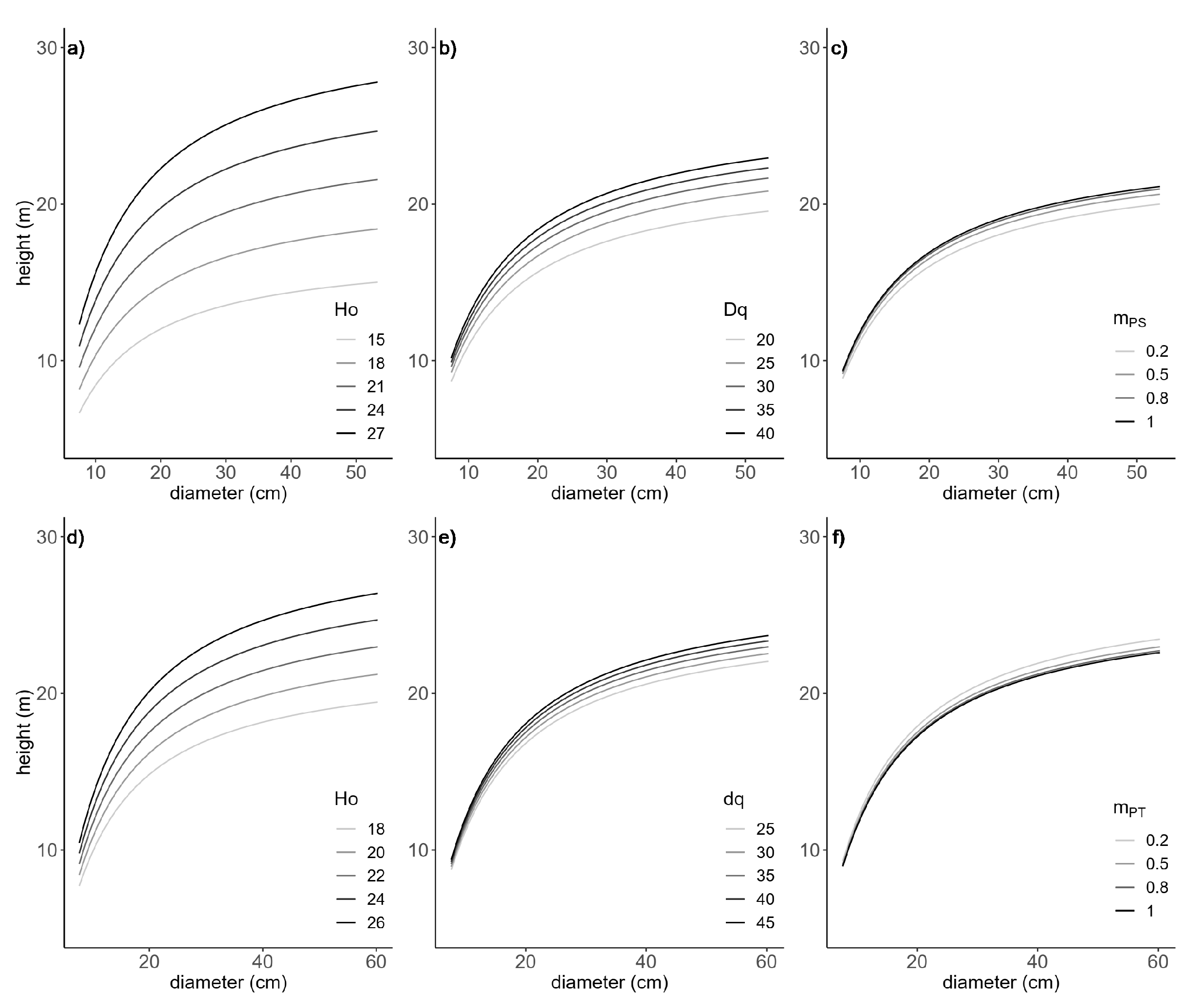
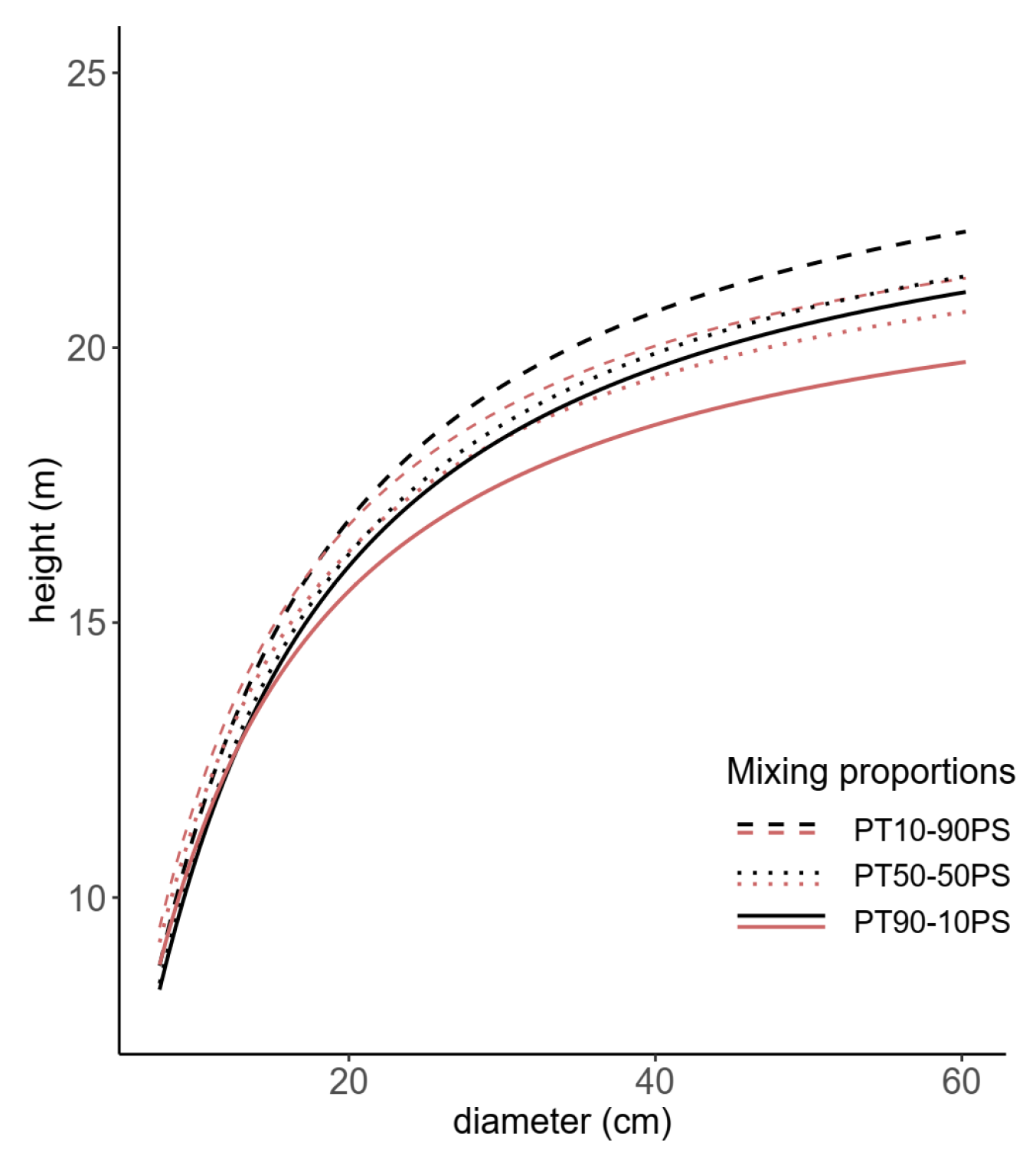
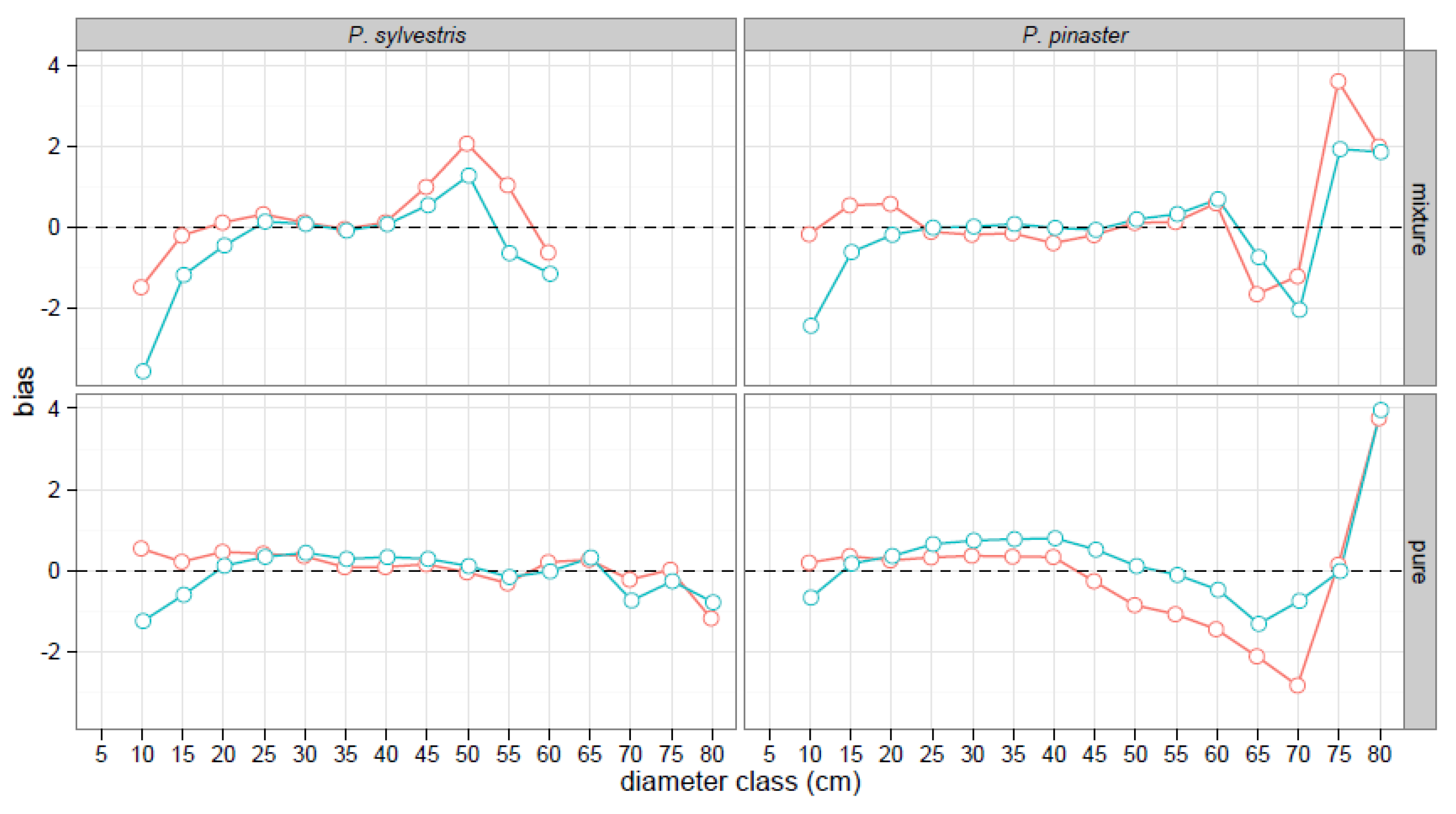
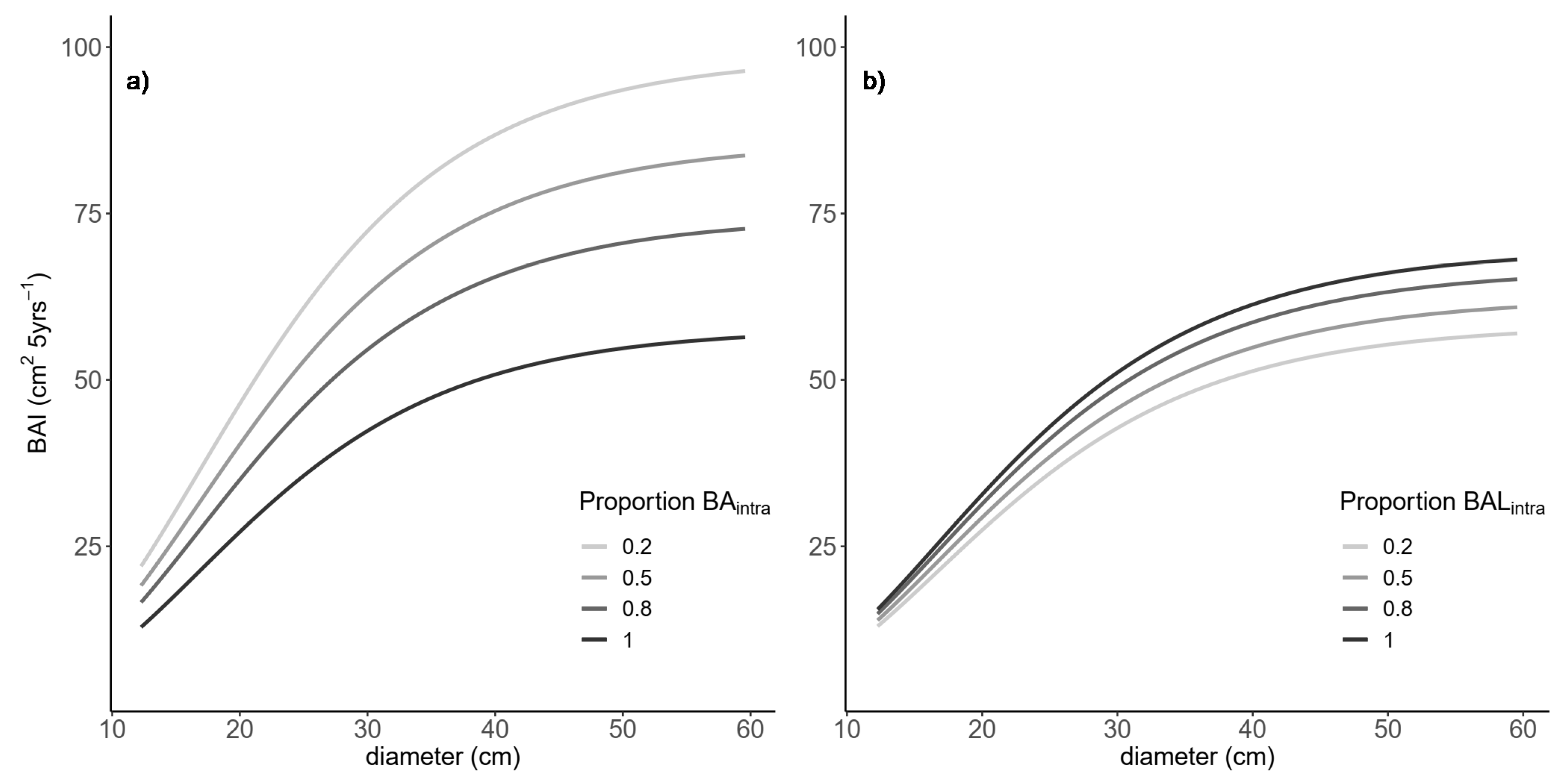
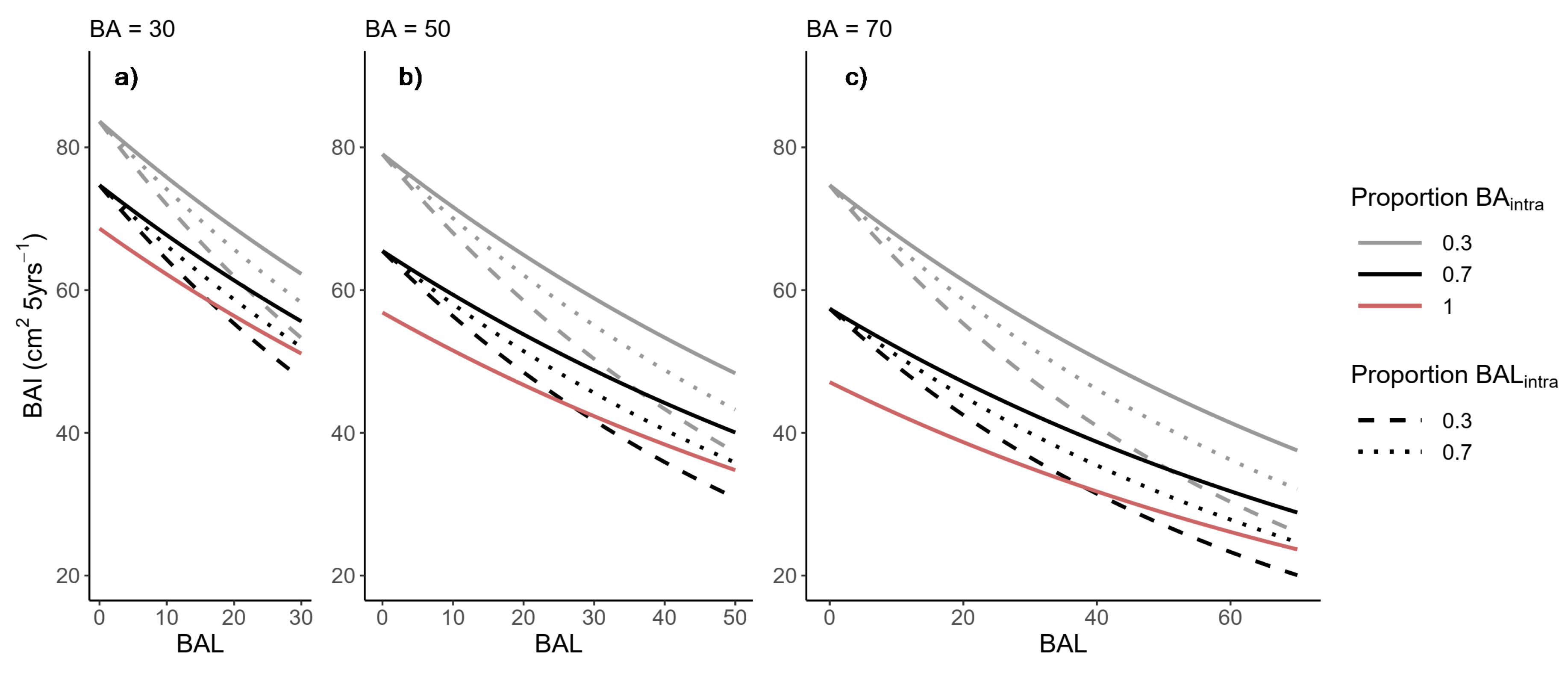
| Variable | Scots Pine | Maritime Pine | ||||||||||
|---|---|---|---|---|---|---|---|---|---|---|---|---|
| Pure Stands | Mixed Stands | Pure Stands | Mixed Stands | |||||||||
| mean | min | max | mean | min | max | mean | min | max | mean | min | max | |
| d | 28.54 | 7.80 | 52.20 | 27.86 | 7.50 | 53.30 | 31.60 | 10.80 | 58.00 | 31.60 | 7.65 | 60.25 |
| h | 19.50 | 5.40 | 28.20 | 18.75 | 8.20 | 30.20 | 17.07 | 3.70 | 27.00 | 19.52 | 4.90 | 30.30 |
| BAI | 28.30 | 2.64 | 97.07 | 23.60 | 1.29 | 124.04 | 34.86 | 2.31 | 130.18 | 52.15 | 3.98 | 143.27 |
| CR | 0.25 | 0.04 | 0.54 | 0.24 | 0.06 | 0.74 | 0.25 | 0.06 | 0.54 | 0.23 | 0.06 | 0.61 |
| Rh | 0.92 | 0.23 | 1.19 | 0.88 | 0.39 | 1.26 | 0.92 | 0.24 | 1.20 | 0.93 | 0.32 | 1.20 |
| Ho | 21.31 | 16.53 | 25.67 | 20.2 | 15.0 | 26.7 | 18.43 | 14.89 | 22.46 | 21.50 | 15.00 | 26.90 |
| Do | 39.99 | 26.96 | 48.41 | 37.22 | 23.9 | 46.92 | 42.61 | 33.16 | 50.17 | 43.94 | 32.04 | 50.86 |
| dq | 29.86 | 21.54 | 39.26 | 29.5 | 20.5 | 40.6 | 32.06 | 21.99 | 40.31 | 37.90 | 27.50 | 48.0 |
| d/dq | 0.95 | 0.25 | 1.71 | 0.85 | 0.26 | 1.77 | 0.98 | 0.41 | 1.87 | 1.11 | 0.31 | 1.77 |
| SI | 23 | 17 | 31 | 22 | 14 | 29 | 20 | 17 | 28 | 22 | 17 | 27 |
| m | 0.94 | 0.93 | 1.00 | 0.47 | 0.33 | 0.71 | 0.99 | 0.95 | 1.00 | 0.54 | 0.29 | 0.67 |
| BA | 47.76 | 29.38 | 62.88 | 54.06 | 29.56 | 72.16 | 56.66 | 33.29 | 68.16 | 54.93 | 29.56 | 72.16 |
| BAintra | 47.63 | 29.27 | 62.34 | 27.21 | 13.03 | 45.87 | 58.87 | 37.53 | 70.31 | 33.17 | 11.09 | 49.27 |
| BAinter | 2.89 | 0 | 8.18 | 29.92 | 11.09 | 49.27 | 0.81 | 0 | 3.02 | 24.96 | 13.02 | 45.87 |
| BAL | 31.88 | 0 | 65.34 | 41.97 | 0 | 74.67 | 35.75 | 0 | 69.45 | 27.52 | 0 | 69.51 |
| BALintra | 29.23 | 0 | 61.37 | 16.52 | 0.00 | 44.72 | 35.44 | 0 | 69.45 | 18.97 | 0.00 | 47.92 |
| BALinter | 2.65 | 0 | 7.09 | 25.48 | 0.00 | 48.66 | 0.31 | 0 | 0 | 8.55 | 0.00 | 45.87 |
| Scots Pine | Maritime Pine | ||||
|---|---|---|---|---|---|
| Fixed parameters | 0.864843 | (0.07180) | 1.069423 | (0.08921) | |
| 0.915575 | (0.03974) | 0.831289 | (0.04814) | ||
| 0.118576 | (0.03133) | 0.122623 | (0.04080) | ||
| 0.033849 | (0.01055) | ||||
| −0.023208 | (0.01371) | ||||
| −7.102191 | (0.52549) | −8.114589 | (0.78582) | ||
| Variance components | 4.5447 | 8.5504 | |||
| 3.24 × 10−6 | 0.0355 | ||||
| Variance function | 1.2608 | 0.7054 | |||
| Fit statistics | RMSE | 1.5626 | 1.3770 | ||
| AIC | 3406.9 | 2901.3 | |||
| ∆AIC | 7.2 | 1.7 | |||
| Stand Composition | Species | n | Fitted Models | Lizarralde * | ||
|---|---|---|---|---|---|---|
| RMSE | EF | RMSE | EF | |||
| Mixed | Scots pine | 721 | 1.69 | 0.74 | 1.88 | 0.68 |
| Maritime pine | 738 | 1.88 | 0.66 | 1.89 | 0.65 | |
| Pure | Scots pine | 3983 | 1.73 | 0.81 | 1.79 | 0.79 |
| Maritime pine | 2089 | 1.60 | 0.78 | 1.68 | 0.76 | |
| Species | Competition Structure * | AICc | Δ AICc | ||||||
|---|---|---|---|---|---|---|---|---|---|
| Scots pine | BA | BAL | 5505.3 | 0 | 0.53 | ||||
| BA | BALintra | BALinter | 5507.0 | 1.77 | 0.22 | ||||
| BAintra | BAinter | BAL | 5507.3 | 2.05 | 0.19 | ||||
| BAintra | BALintra | BALinter | 5509.8 | 4.52 | 0.06 | ||||
| BALintra | BALinter | 5517.4 | 12.13 | 0.00 | |||||
| BA | 5517.9 | 12.61 | 0.00 | ||||||
| BAL | 5517.9 | 12.65 | 0.00 | ||||||
| BAintra | BAinter | 5519.9 | 14.59 | 0.00 | |||||
| Maritime pine | BAintra | BALintra | BALinter | 6097.1 | 0 | 0.86 | |||
| BAintra | BAL | 6101.0 | 3.89 | 0.12 | |||||
| BA | BALintra | BALinter | 6106.3 | 9.19 | 0.01 | ||||
| BAL | 6106.4 | 9.23 | 0.01 | ||||||
| BALintra | BALinter | 6108.4 | 11.28 | 0.00 | |||||
| BA | 6116.9 | 19.75 | 0.00 | ||||||
| BAintra | BAinter | 6117.2 | 20.10 | 0.00 | |||||
| BA | BAL | 6142.1 | 45.01 | 0.00 | |||||
| Scots Pine | Maritime Pine | ||
|---|---|---|---|
| Fixed parameters | 4.427540 (0.2311) | 4.467207 (0.1614) | |
| −0.131687 (0.0122) | −0.089010 (0.0086) | ||
| 0.828948 (0.2315) | 1.009121 (0.2491) | ||
| BA | −0.016671 (0.0043) | ||
| BAintra | −0.009411 (0.0029) | ||
| BAL | −0.011216 (0.0024) | ||
| BALintra | −0.009832 (0.0020) | ||
| BALinter | −0.017252 (0.0052) | ||
| Variance components | 0.0234 | 0.0401 | |
| 0.0053 | 0.0147 | ||
| Variance function | 0.9282 | 0.87767 | |
| Cross-evaluation | Bias | 0.1104 | 0.5769 |
| EF | 0.3267 | 0.4304 | |
| RMSE | 15.422 | 19.851 |
© 2019 by the authors. Licensee MDPI, Basel, Switzerland. This article is an open access article distributed under the terms and conditions of the Creative Commons Attribution (CC BY) license (http://creativecommons.org/licenses/by/4.0/).
Share and Cite
Riofrío, J.; del Río, M.; Maguire, D.A.; Bravo, F. Species Mixing Effects on Height–Diameter and Basal Area Increment Models for Scots Pine and Maritime Pine. Forests 2019, 10, 249. https://doi.org/10.3390/f10030249
Riofrío J, del Río M, Maguire DA, Bravo F. Species Mixing Effects on Height–Diameter and Basal Area Increment Models for Scots Pine and Maritime Pine. Forests. 2019; 10(3):249. https://doi.org/10.3390/f10030249
Chicago/Turabian StyleRiofrío, José, Miren del Río, Douglas A. Maguire, and Felipe Bravo. 2019. "Species Mixing Effects on Height–Diameter and Basal Area Increment Models for Scots Pine and Maritime Pine" Forests 10, no. 3: 249. https://doi.org/10.3390/f10030249
APA StyleRiofrío, J., del Río, M., Maguire, D. A., & Bravo, F. (2019). Species Mixing Effects on Height–Diameter and Basal Area Increment Models for Scots Pine and Maritime Pine. Forests, 10(3), 249. https://doi.org/10.3390/f10030249






